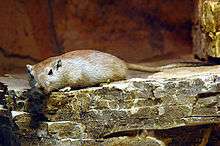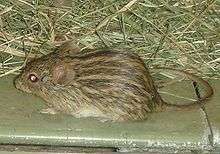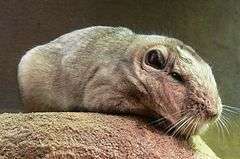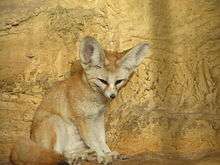List of mammals of Algeria
This is a list of the mammal species recorded in Algeria. There are 120 mammal species in Algeria, of which 3 are critically endangered, 2 are endangered, 10 are vulnerable, and 3 are near-threatened. 1 of the species listed for Algeria is extinct and 1 can no longer be found in the wild.[1]
The following tags are used to highlight each species' conservation status as assessed by the IUCN:
| EX | Extinct | No reasonable doubt that the last individual has died. |
| EW | Extinct in the wild | Known only to survive in captivity or as a naturalized populations well outside its previous range. |
| CR | Critically endangered | The species is in imminent risk of extinction in the wild. |
| EN | Endangered | The species is facing an extremely high risk of extinction in the wild. |
| VU | Vulnerable | The species is facing a high risk of extinction in the wild. |
| NT | Near threatened | The species does not meet any of the criteria that would categorise it as risking extinction but it is likely to do so in the future. |
| LC | Least concern | There are no current identifiable risks to the species. |
| DD | Data deficient | There is inadequate information to make an assessment of the risks to this species. |
Some species were assessed using an earlier set of criteria. Species assessed using this system have the following instead of near threatened and least concern categories:
| LR/cd | Lower risk/conservation dependent | Species which were the focus of conservation programmes and may have moved into a higher risk category if that programme was discontinued. |
| LR/nt | Lower risk/near threatened | Species which are close to being classified as vulnerable but are not the subject of conservation programmes. |
| LR/lc | Lower risk/least concern | Species for which there are no identifiable risks. |
Subclass: Theria
Infraclass: Eutheria
Order: Macroscelidea (elephant shrews)
Often called sengisi, the elephant shrews or jumping shrews are native to southern Africa. Their common English name derives from their elongated flexible snout and their resemblance to the true shrews.
- Family: Macroscelididae (elephant shrews)
- Genus: Elephantulus
- North African elephant shrew Elephantulus rozeti LC
- Genus: Elephantulus
Order: Hyracoidea (hyraxes)
The hyraxes are any of four species of fairly small, thickset, herbivorous mammals in the order Hyracoidea. About the size of a domestic cat they are well-furred, with rounded bodies and a stumpy tail. They are native to Africa and the Middle East.
- Family: Procaviidae (hylaxes)
- Genus: Heterohyrax
- Yellow-spotted rock hyrax Heterohyrax brucei LC
- Genus: Procavia
- Cape hyrax Procavia capensis LC
- Genus: Heterohyrax
Order: Primates
The order Primates contains humans and their closest relatives: lemurs, lorisoids, tarsiers, monkeys, and apes.
- Suborder: Haplorhini
- Infraorder: Simiiformes
- Parvorder: Catarrhini
- Superfamily: Cercopithecoidea
- Family: Cercopithecidae (Old World monkeys)
- Genus: Macaca
- Barbary macaque Macaca sylvanus EN
- Genus: Macaca
- Family: Cercopithecidae (Old World monkeys)
- Superfamily: Cercopithecoidea
- Parvorder: Catarrhini
- Infraorder: Simiiformes
Order: Rodentia (rodents)
Rodents make up the largest order of mammals, with over 40 percent of mammalian species. They have two incisors in the upper and lower jaw which grow continually and must be kept short by gnawing. Most rodents are small though the capybara can weigh up to 45 kg (100 lb).
- Suborder: Hystricomorpha
- Family: Hystricidae (Old World porcupines)
- Genus: Hystrix
- Crested porcupine Hystrix cristata LC
- Genus: Hystrix
- Family: Ctenodactylidae
- Genus: Ctenodactylus
- Common gundi Ctenodactylus gundi LC
- Val's gundi Ctenodactylus vali DD
- Genus: Massoutiera
- Mzab gundi Massoutiera mzabi LC
- Genus: Ctenodactylus
- Family: Hystricidae (Old World porcupines)
- Suborder: Sciurognathi
- Family: Sciuridae (squirrels)
- Subfamily: Xerinae
- Tribe: Xerini
- Genus: Atlantoxerus
- Barbary ground squirrel Atlantoxerus getulus LC
- Genus: Atlantoxerus
- Tribe: Xerini
- Subfamily: Xerinae
- Family: Gliridae (dormice)
- Subfamily: Leithiinae
- Genus: Eliomys
- Asian garden dormouse Eliomys melanurus LC
- Maghreb garden dormouse Eliomys munbyanus LC
- Genus: Eliomys
- Subfamily: Leithiinae
- Family: Dipodidae (jerboas)
- Subfamily: Dipodinae
- Genus: Jaculus
- Lesser Egyptian jerboa Jaculus jaculus LC
- Greater Egyptian jerboa Jaculus orientalis LC
- Genus: Jaculus
- Subfamily: Dipodinae
- Family: Muridae (mice, rats, voles, gerbils, hamsters, etc.)
- Subfamily: Deomyinae
- Genus: Acomys
- Seurat's spiny mouse Acomys seurati LC
- Genus: Acomys
- Subfamily: Gerbillinae
- Genus: Dipodillus
- North African gerbil Dipodillus campestris LC
- Genus: Gerbillus
- Lesser gerbil Gerbillus gerbillus] LC
- Pygmy gerbil Gerbillus henleyi LC
- Balochistan gerbil Gerbillus nanus LC
- Lesser short-tailed gerbil Gerbillus simoni LC
- Tarabul's gerbil Gerbillus tarabuli LC
- Genus: Meriones
- Sundevall's jird Meriones crassus LC
- Libyan jird Meriones libycus LC
- Shaw's jird Meriones shawi LC
- Genus: Pachyuromys
- Fat-tailed gerbil Pachyuromys duprasi LC
- Genus: Psammomys
- Sand rat Psammomys obesus LC
- Thin sand rat Psammomys vexillaris DD
- Genus: Dipodillus
- Subfamily: Murinae
- Genus: Apodemus
- Wood mouse Apodemus sylvaticus LC
- Genus: Lemniscomys
- Barbary striped grass mouse Lemniscomys barbarus LC
- Genus: Mus
- Algerian mouse Mus spretus LC
- Genus: Apodemus
- Subfamily: Deomyinae
- Family: Sciuridae (squirrels)
Order: Lagomorpha (lagomorphs)
The lagomorphs comprise two families, Leporidae (hares and rabbits), and Ochotonidae (pikas). Though they can resemble rodents, and were classified as a superfamily in that order until the early 20th century, they have since been considered a separate order. They differ from rodents in a number of physical characteristics, such as having four incisors in the upper jaw rather than two.
- Family: Leporidae (rabbits, hares)
- Genus: Oryctolagus
- European rabbit Oryctolagus cuniculus LR/nt
- Genus: Lepus
- Cape hare Lepus capensis LR/lc
- African savanna hare Lepus microtis LR/lc
- Genus: Oryctolagus
Order: Erinaceomorpha (hedgehogs and gymnures)
The order Erinaceomorpha contains a single family, Erinaceidae, which comprise the hedgehogs and gymnures. The hedgehogs are easily recognised by their spines while gymnures look more like large rats.
- Family: Erinaceidae (hedgehogs)
- Subfamily: Erinaceinae
- Genus: Atelerix
- North African hedgehog Atelerix algirus LR/lc
- Genus: Hemiechinus
- Desert hedgehog Hemiechinus aethiopicus LR/lc
- Genus: Atelerix
- Subfamily: Erinaceinae
Order: Soricomorpha (shrews, moles, and solenodons)
The "shrew-forms" are insectivorous mammals. The shrews and solenodons closely resemble mice while the moles are stout-bodied burrowers.
- Family: Soricidae (shrews)
- Subfamily: Crocidurinae
- Genus: Crocidura
- Mauritanian shrew Crocidura lusitania LC
- Greater white-toothed shrew Crocidura russula LC
- Lesser white-toothed shrew Crocidura suaveolens LR/lc
- Whitaker's shrew Crocidura whitakeri LC
- Genus: Suncus
- Etruscan shrew Suncus etruscus LC
- Genus: Crocidura
- Subfamily: Crocidurinae
Order: Chiroptera (bats)
The bats' most distinguishing feature is that their forelimbs are developed as wings, making them the only mammals in the world naturally capable of flight. Bat species account for about 20% of all mammals.
- Family: Vespertilionidae
- Subfamily: Myotinae
- Genus: Myotis
- Long-fingered bat Myotis capaccinii VU
- Geoffroy's bat Myotis emarginatus VU
- Felten's myotis Myotis punicus DD
- Genus: Myotis
- Subfamily: Vespertilioninae
- Genus: Eptesicus
- Serotine bat Eptesicus serotinus LR/lc
- Genus: Hypsugo
- Savi's pipistrelle Hypsugo savii LR/lc
- Genus: Nyctalus
- Greater noctule bat Nyctalus lasiopterus LR/nt
- Lesser noctule Nyctalus leisleri LR/nt
- Genus: Otonycteris
- Desert long-eared bat Otonycteris hemprichii LR/lc
- Genus: Pipistrellus
- Egyptian pipistrelle Pipistrellus deserti LC
- Kuhl's pipistrelle Pipistrellus kuhlii LC
- Common pipistrelle Pipistrellus pipistrellus LC
- Rüppell's pipistrelle Pipistrellus rueppelli LC
- Genus: Plecotus
- Canary big-eared bat Plecotus teneriffae DD
- Genus: Eptesicus
- Subfamily: Miniopterinae
- Genus: Miniopterus
- Common bent-wing bat Miniopterus schreibersii LC
- Genus: Miniopterus
- Subfamily: Myotinae
- Family: Rhinopomatidae
- Genus: Rhinopoma
- Lesser mouse-tailed bat Rhinopoma hardwickei LC
- Greater mouse-tailed bat Rhinopoma microphyllum LC
- Genus: Rhinopoma
- Family: Molossidae
- Genus: Tadarida
- Egyptian free-tailed bat Tadarida aegyptiaca LC
- European free-tailed bat Tadarida teniotis LR/lc
- Genus: Tadarida
- Family: Emballonuridae
- Genus: Taphozous
- Naked-rumped tomb bat Taphozous nudiventris LC
- Genus: Taphozous
- Family: Nycteridae
- Genus: Nycteris
- Egyptian slit-faced bat Nycteris thebaica LC
- Genus: Nycteris
- Family: Rhinolophidae
- Subfamily: Rhinolophinae
- Genus: Rhinolophus
- Blasius's horseshoe bat Rhinolophus blasii NT
- Geoffroy's horseshoe bat Rhinolophus clivosus LC
- Mediterranean horseshoe bat Rhinolophus euryale VU
- Greater horseshoe bat Rhinolophus ferrumequinum LR/nt
- Lesser horseshoe bat Rhinolophus hipposideros LC
- Mehely's horseshoe bat Rhinolophus mehelyi VU
- Genus: Rhinolophus
- Subfamily: Hipposiderinae
- Genus: Asellia
- Trident leaf-nosed bat Asellia tridens LC
- Genus: Hipposideros
- Sundevall's roundleaf bat Hipposideros caffer LC
- Genus: Asellia
- Subfamily: Rhinolophinae
Order: Cetacea (whales)
The order Cetacea includes whales, dolphins and porpoises. They are the mammals most fully adapted to aquatic life with a spindle-shaped nearly hairless body, protected by a thick layer of blubber, and forelimbs and tail modified to provide propulsion underwater.
Species listed below also includes species being recorded in Levantine Sea except for gray whale.[2]
- Suborder: Mysticeti
- Family: Balaenidae (right whales)
- Genus: Eubalaena
- Family: Balaenidae (right whales)
- Subfamily: Megapterinae
- Genus: Megaptera
- Humpback whale Megaptera novaeangliae LC[4]
- Family: Balaenopteridae
- Genus: Balaenoptera
- Common minke whale Balaenoptera acutorostrata LC
- Fin whale Balaenoptera physalus EN
- Blue whale Balaenoptera m. musculus EN (possible)[5]
- Genus: Balaenoptera
- Genus: Megaptera
- Suborder: Odontoceti
- Superfamily: Platanistoidea
- Family: Delphinidae (marine dolphins)
- Genus: Steno
- Rough-toothed dolphin Steno bredanensis DD
- Genus: Delphinus
- Short-beaked common dolphin Delphinus delphis LR/lc
- Genus: Orcinus
- Orca Orcinus orca LR/cd
- Genus: Pseudorca
- False killer whale Pseudorca crassidens DD
- Genus: Globicephala
- Long-finned pilot whale Globicephala melas LR/lc
- Genus: Grampus
- Risso's dolphin Grampus griseus LC
- Genus: Stenella
- Striped dolphin Stenella coeruleoalba DD
- Genus Tursiops
- Common bottlenose dolphin 'Tursiops truncatus LC
- Genus: Steno
- Family Physeteridae (sperm whales)
- Genus: Physeter
- Sperm whale Physeter catodon VU
- Genus: Physeter
- Family: Delphinidae (marine dolphins)
- Superfamily Ziphioidea (beaked whales)
- Family Ziphidae
- Genus: Ziphius
- Cuvier's beaked whale Ziphius cavirostris LC
- Genus: Ziphius
- Family Ziphidae
- Superfamily: Platanistoidea
Order: Carnivora (carnivorans)
There are over 260 species of carnivorans, the majority of which feed primarily on meat. They have a characteristic skull shape and dentition.
- Suborder: Feliformia
- Family: Felidae (cats)
- Subfamily: Felinae
- Genus: Acinonyx
- Northwest African cheetah Acinonyx jubatus hecki CR
- Genus: Caracal
- Caracal Caracal caracal LC
- Genus: Felis
- Saharan sand cat Felis margarita margarita NT
- African wildcat Felis silvestris lybica LC
- Genus: Leptailurus
- Serval Leptailurus serval LC
- Genus: Acinonyx
- Subfamily: Pantherinae
- Genus: Panthera
- Barbary lion Panthera leo leo EW
- African leopard Panthera pardus pardus NT
- Genus: Panthera
- Subfamily: Felinae
- Family: Viverridae (civets, mongooses, etc.)
- Subfamily: Viverrinae
- Genus: Genetta
- Common genet Genetta genetta LR/lc
- Genus: Genetta
- Subfamily: Viverrinae
- Family: Herpestidae (mongooses)
- Genus: Atilax
- Marsh mongoose Atilax paludinosus LR/lc
- Genus: Herpestes
- Egyptian mongoose Herpestes ichneumon LR/lc
- Genus: Atilax
- Family: Hyaenidae (hyaenas)
- Genus: Hyaena
- Striped hyena Hyaena hyaena LR/nt
- Genus: Hyaena
- Family: Felidae (cats)
- Suborder: Caniformia
- Family: Canidae (dogs, foxes)
- Genus: Vulpes
- Rueppell's fox Vulpes rueppelli LC
- Red fox Vulpes vulpes LC
- Fennec Vulpes zerda LC
- Genus: Canis
- Algerian wolf Canis anthus algirensis NE
- Egyptian wolf Canis anthus lupaster NE
- Genus: Lycaon
- African wild dog Lycaon pictus EN
- Genus: Vulpes
- Family: Mustelidae (mustelids)
- Genus: Mustela
- Least weasel Mustela nivalis LR/lc
- Genus: Ictonyx
- Saharan striped polecat Ictonyx libyca LR/lc
- Genus: Mellivora
- Ratel Mellivora capensis LR/lc
- Genus: Lutra
- European otter Lutra lutra NT
- Genus: Mustela
- Family: Phocidae (earless seals)
- Genus: Monachus
- Mediterranean monk seal Monachus monachus EN
- Genus: Monachus
- Family: Canidae (dogs, foxes)
Order: Artiodactyla (even-toed ungulates)
The even-toed ungulates are ungulates whose weight is borne about equally by the third and fourth toes, rather than mostly or entirely by the third as in perissodactyls. There are about 220 artiodactyl species, including many that are of great economic importance to humans.
- Family: Suidae (pigs)
- Family: Hippopotamidae (hippopotamuses)
- Genus: Hippopotamus
- Hippopotamus Hippopotamus amphibius VU (Possibly Extinct)
- Genus: Hippopotamus
- Family: Giraffidae
- Genus: Giraffa
- West African giraffe Giraffa camelopardalis peralta EN
- Genus: Giraffa
- Family: Cervidae (deer)
- Subfamily: Cervinae
- Genus: Cervus
- Red deer Cervus elaphus LR/lc
- Genus: Dama
- Fallow deer Dama dama LC (introduced)
- Genus: Cervus
- Subfamily: Cervinae
- Family: Bovidae (cattle, antelope, sheep, goats)
- Subfamily: Alcelaphinae
- Genus: Alcelaphus
- Hartebeest Alcelaphus buselaphus LR/cd (Regionally Extinct)
- Genus: Alcelaphus
- Subfamily: Antilopinae
- Genus: Gazella
- Cuvier's gazelle Gazella cuvieri EN
- Dama gazelle Gazella dama CR
- Dorcas gazelle Gazella dorcas VU
- Rhim gazelle Gazella leptoceros EN
- Red gazelle Gazella rufina DD
- Genus: Gazella
- Subfamily: Caprinae
- Genus: Ammotragus
- Barbary sheep Ammotragus lervia VU
- Genus: Ammotragus
- Subfamily: Hippotraginae
- Genus: Addax
- Addax Addax nasomaculatus CR
- Genus: Oryx
- Scimitar oryx Oryx dammah EW
- Genus: Addax
- Subfamily: Alcelaphinae
See also
- List of chordate orders
- List of regional mammals lists
- List of prehistoric mammals
- Mammal classification
- New mammal species
Notes
- ↑ This list is derived from the IUCN Red List which lists species of mammals and includes those mammals that have recently been classified as extinct (since 1500 AD). The taxonomy and naming of the individual species is based on those used in existing Wikipedia articles as of 21 May 2007 and supplemented by the common names and taxonomy from the IUCN, Smithsonian Institution, or University of Michigan where no Wikipedia article was available.
- ↑ Update on the Cetacean Fauna of the Mediterranean Levantine Basin
- ↑ Brown.G.S. (1986). "Twentieth-century Records of Right Whales(Eubalaena glacialis) in the Northeast Atlantic Ocean" (PDF). Report of the International Whaling Commission Special Issue 10: 121–127. Retrieved 2013-10-10.
- ↑ Are humpback whales electing the Mediterranean Sea as new residence?
- ↑ Frantzis A., Alexiadou P., Paximadis G., Politi E., Gannier A., Corsini-Foka M. (2003). "Current knowledge of the cetacean fauna of the Greek Seas" (pdf). Journal of Cetacean Research and Management. International Whaling Commission. 5 (3): 219–232. Retrieved 2016-04-16.
References
- "The IUCN Red List of Threatened Species: Mammals of Algeria". IUCN. 2001. Retrieved 22 May 2007.
- "Mammal Species of the World". Smithsonian National Museum of Natural History. 2005. Archived from the original on 27 April 2007. Retrieved 22 May 2007.
- "Animal Diversity Web". University of Michigan Museum of Zoology. 1995–2006. Retrieved 22 May 2007.












